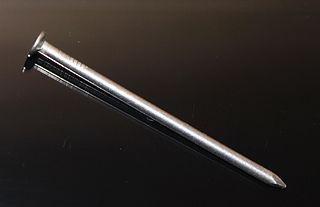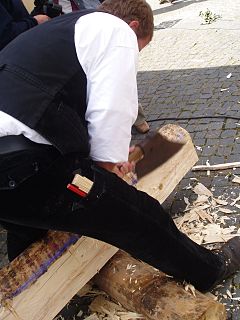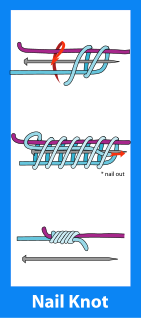Related Research Articles

In woodworking and construction, a nail is a small object made of metal which is used as a fastener, as a peg to hang something, or sometimes as a decoration. Generally, nails have a sharp point on one end and a flattened head on the other, but headless nails are available. Nails are made in a great variety of forms for specialized purposes. The most common is a wire nail. Other types of nails include pins, tacks, brads, spikes, and cleats.

Woodworking is the skill of making items from wood, and includes cabinet making, wood carving, joinery, carpentry, and woodturning.

Lumber, also known as timber, is wood that has been processed into beams and planks, a stage in the process of wood production. Lumber is mainly used for structural purposes but has many other uses as well.

Joinery is a part of woodworking that involves joining pieces of wood or lumber, to produce more complex items. Some wood joints employ fasteners, bindings, or adhesives, while others use only wood elements. The characteristics of wooden joints - strength, flexibility, toughness, appearance, etc. - derive from the properties of the materials involved and the purpose of the joint. Therefore, different joinery techniques are used to meet differing requirements. For example, the joinery used to construct a house can be different from that used to make puzzle toys, although some concepts overlap. In British English usage it is distinguished from carpentry which relates to structural timber work.

In woodworking, hewing is the process of converting a log from its rounded natural form into lumber (timber) with more or less flat surfaces using primarily an axe. It is an ancient method, and before the advent of the industrial-era type of sawmills, it was a standard way of squaring up wooden beams for timber framing. Today it is still used occasionally for that purpose by anyone who has logs, needs beams, and cannot or would prefer not to pay for finished lumber. Thus, homesteaders on frugal budgets, for example, may hew their own lumber rather than buy it.

A nail is a claw-like plate at the tip of the fingers and toes in most primates. Nails correspond to claws found in other animals. Fingernails and toenails are made of a tough protective protein called alpha-keratin, which is a polymer. Alpha-keratin is found in the hooves, claws and horns of vertebrates.

A framing hammer is a form of claw hammer used for heavy wood construction, particularly house framing and concrete formwork. It is a heavy duty rip hammer with a straight claw and a wood, metal, or fiberglass handle. Head weights vary from 20 to 32 ounces for steel, and 12 to 16 ounces for titanium. Heavy heads, longer handles and milled faces allow for driving large nails quickly into dimensional lumber. Other features include a sharp checkerboard "milled" face for gripping nails, and, since the 1980s, an unusually large and short face for increasing driving area without increasing weight.

A nail gun, nailgun or nailer is a form of hammer used to drive nails into wood or other materials. It is usually driven by compressed air (pneumatic), electromagnetism, highly flammable gases such as butane or propane, or, for powder-actuated tools, a small explosive charge. Nail guns have in many ways replaced hammers as tools of choice among builders.

Framing, in construction, is the fitting together of pieces to give a structure support and shape. Framing materials are usually wood, engineered wood, or structural steel. The alternative to framed construction is generally called mass wall construction, where horizontal layers of stacked materials such as log building, masonry, rammed earth, adobe, etc. are used without framing.

The nail knot, also known as the tube knot or gryp knot, is mostly used in carp and fly-fishing. The nail knot was named because a nail was inserted as a guide when threading the line. Today, it is easier to use a small straw. The nail knot is an important fishing knot used to join two lines of different diameters and allows for line diameters to diminish down to the fly. I.E., it is useful for attaching your backing to the fly line, and your fly line to the leader, or tippet. The knot can be tied in multiple ways and is uniform.
This glossary of woodworking lists a number of specialized terms and concepts used in woodworking, carpentry, and related disciplines.

A slater, or slate mason, is a tradesperson who covers buildings with slate.

Timber recycling or wood recycling is the process of turning waste timber into usable products. Recycling timber is a practice that was popularized in the early 1990s as issues such as deforestation and climate change prompted both timber suppliers and consumers to turn to a more sustainable timber source. Recycling timber is the environmentally friendliest form of timber production and is very common in countries such as Australia and New Zealand where supplies of old wooden structures are plentiful. Timber can be chipped down into wood chips which can be used to heat homes or generate electricity.

Reclaimed lumber is processed wood retrieved from its original application for purposes of subsequent use. Most reclaimed lumber comes from timbers and decking rescued from old barns, factories and warehouses, although some companies use wood from less traditional structures such as boxcars, coal mines and wine barrels. Reclaimed or antique lumber is used primarily for decoration and home building, for example for siding, architectural details, cabinetry, furniture and flooring.

A cat's paw or cat's claw is a standard carpenter's tool, consisting of a round, hexagonal, or flat bar that curves at one end to form a pointed, cup-shaped tip with a V-shaped cleft for gripping nailheads. Popular retail outlets currently call these a claw bar if it has a claw on each end, or a moulding bar if it has a claw on one end and a flat pry bar on the other. It essentially works as a small crowbar. To use the tool the user holds the tool's shank with one hand and drives the claw around a nailhead with a hammer. When the V is firmly seated around the nail's shank, the users pull the bar back to raise the head, then finishes pulling the nail with the hammer's claw. The cat's paw is well designed for demolition work, but because it tears up the wood around the nailhead, it should not be used for finish work.

Dog grooming refers to both the hygienic care and cleaning of a dog, as well as a process by which a dog's physical appearance is enhanced for showing or other types of competition. A dog groomer is a person who earns their living grooming dogs.

Wood splitting is an ancient technique used in carpentry to make lumber for making wooden objects, some basket weaving, and to make firewood. Unlike wood sawing, the wood is split along the grain using tools such as a hammer and wedges, splitting maul, cleaving axe, side knife, or froe.

Alvin Clark was a schooner that sailed the Great Lakes for almost two decades. Constructed in 1846 or 1847, it sank during a storm in Green Bay in 1864. It was salvaged in 1969 and moored in Menominee, Michigan, at the Mystery Ship Seaport, located in the Menominee River at the foot of Sixth Avenue. The ship was designated a Michigan State Historic Site in 1972 and listed on the National Register of Historic Places in 1974; Alvin Clark was removed from the National Register of Historic Places on June 10, 2020. Although the schooner was in pristine condition when raised, no plans were in place for its conservation, and the ship rapidly deteriorated. The remains of Alvin Clark were destroyed in 1994.

The Sport was a tugboat, built in 1873 and wrecked in 1920 in Lake Huron. The wreck site, designated 20UH105, was listed on the National Register of Historic Places in 1992.

A burnisher is a hand tool used in woodworking for creating a burr on a card scraper.
References
- ↑ Falk, Bob & Guy, Brad (2007). Unbuilding : salvaging the architectural treasures of unwanted houses. Newtown, CT: Taunton. pp. 230–234. ISBN 978-1-56158-825-1.
